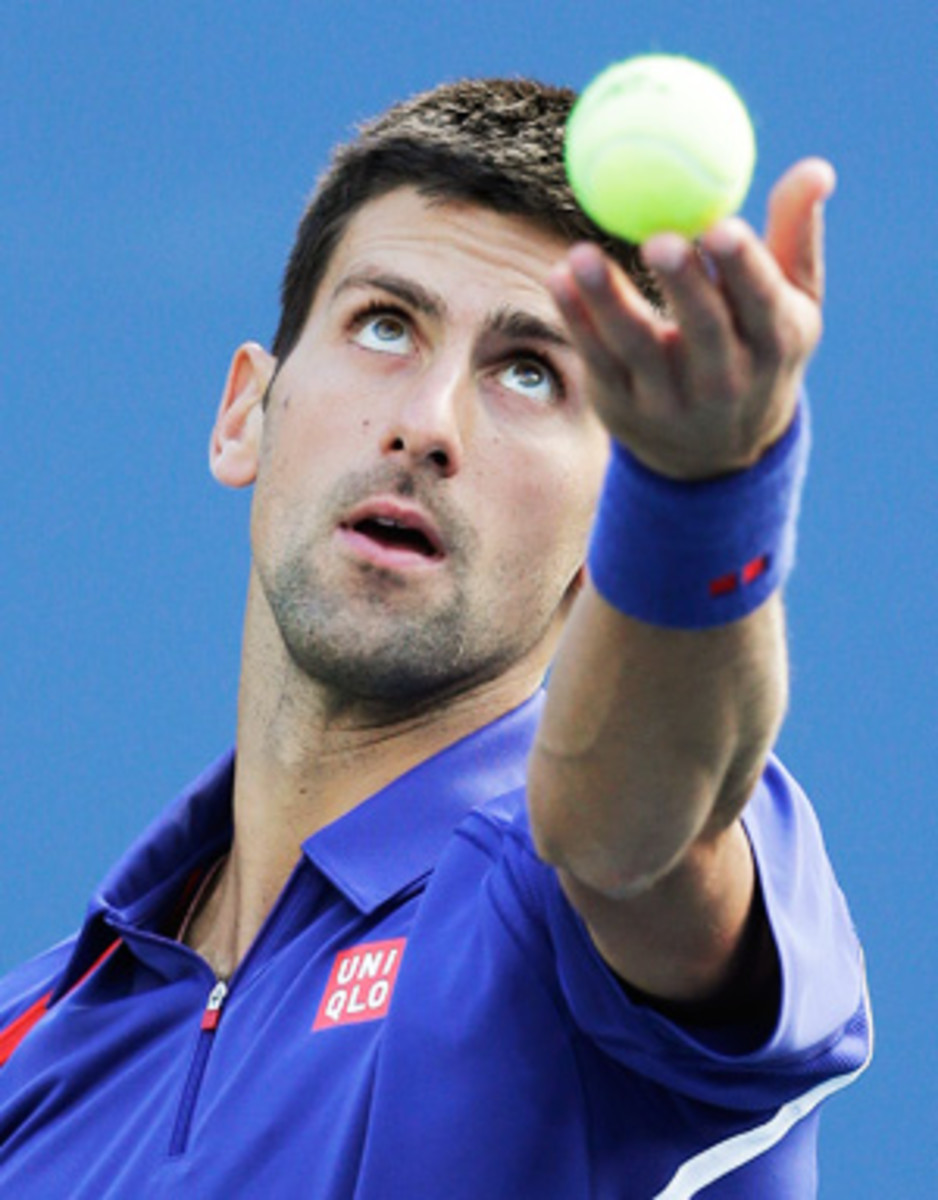The Toss: ATP on the right path with new rule changes?

Noavk Djokovic is often criticized for bouncing the ball many times during his lengthy service routine. (AP)

Another Thursday, another Toss. Last week we gathered a panel of experts to compare Caroline Wozniacki to the trends of recent WTA No. 1s. The readers spoke in the poll, and very few were willing to write off Wozniacki just yet.
This week, Toss regular Ben Rothenberg of The New York Times joins for a discussion across the aisle with the ATP.
Today's Toss:Is the ATP on the right path with its proposed rule changes on no-let serving and new time-violation penalties?
Courtney Nguyen: The ATP has been grabbing its share of post-U.S. Open headlines but, with all due respect to the Richard Gasquets and Martin Klizans of the world, those headlines have been more about some interesting behind-the-scenes decisions rather than on-court play. Two weeks ago the ATP announced two rule changes of note. Let's start with the first one, which allows the play of net-cord serves on a trial basis on the ATP Challenger level only. So, no, we won't be seeing Rafael Nadal scramble forward to return any net-cord serves anytime soon. Bummer, I know.
What do you make of this, Ben?
Ben Rothenberg: I've seen no-let play in action in a couple of formats: World TeamTennis and NCAA men's tennis. As an interesting aside, it's only a rule in college for men, not women. College tennis guru Colette Lewis explains that the men (who call their own lines) used to say "let" after they got aced, which was never a female practice.
In my experience seeing it in action, it really doesn't affect play all that much. Most serves that hit the tape barely touch it, and the serve trajectory is almost unchanged. Then there are those that hit the tape but still keep going forward with decent velocity in a slightly different direction, which forces the returner into quick footwork but generally doesn't change the point. The smallest percentage of serves are the ones that hit the tape and then fall very short in the box, forcing the returner to run forward to get the ball before a second bounce. These are definitely rare, and when the returner can get there in time he or she can usually whack away an easy winner just as often as he or she is unable to reach it.
In other words, it's a net-neutral change. It speeds up matches, and I agree with Billie Jean King that there's no reason to redo serves when hitting the tape with normal rally shots are not. Does it allow for slightly more luck? Sure, but anyone who thinks there isn't a massive amount of luck involved in tennis (and life) is in denial.
Some players on the Challenger circuit don't seem thrilled by being made the guinea pigs for this experiment, but they should realize pretty quickly that the switch isn't all that significant in the end.
Nguyen: Well, it's a neutral change until the first match is decided by one of these calls. Given the penchant for volatile personalities in the Challenger tour, I have to say I'd pay good money to watch a guy go ballistic when he realizes his paycheck got a little bit smaller because of a lucky net-cord serve. The ATP clearly wants to address this issue of game speed and I absolutely want to applaud it for the move.
In addition to the net-cord rule, the Tour announced a change for time violations. Beginning in 2013, umpires may issue a fault penalty, rather than a point penalty, if a player goes over the allotted 25 seconds between serves. Unlike the net-cord rule, this one will be applied on the main ATP Tour.
On paper, I think the rule change is great. It encourages umpires to, you know, do their job and actually enforce the time-violation rule on the books. But that's precisely why the change bothers me. The ATP is going from a rule that offered a more severe punishment for time violations -- which you'd think would be a bigger deterrent -- to a rule that offers more lax punishment so that the umpires are more willing to call it. That's like easing the sentencing guidelines on crimes in hopes of encouraging cops to be more zealous. Does that make any sense?
That's where my skepticism on this new rule comes in. The ATP can change things around all it wants to try to show it's doing its part to speed up the game, a common complaint about the men's game. It's a great PR move. But talk to me next year when umpire Jake Gardner calls it in the first three games on Nadal, Novak Djokovic or Andy Murray. Until then, this is just talk.
Rothenberg: Completely agreed. The old rule was fine, but the people in those tall chairs shrunk when it came time to enforcing it. I actually took out my stopwatch (app) during the Australian Open final this year between Djokovic and Nadal, and measured that both took roughly 40 seconds on average between points (and keep in mind that the Slam time limit is actually just 20 seconds). Djokovic even once took 11 seconds after a let before hitting another first serve, which is probably even more ridiculous.
It wasn't just that the chair umpire in that match didn't give either a point penalty. He took forever to give either player a soft warning. Fans, players and commentators object to chair umpires asserting themselves in a match, but if there is going to be a rule on time limits, there has to be enforcement. Otherwise, what's the point?
I think slow play is more bothersome in person than on TV, probably because you don't have commentators or replays to fill the time. Imagine this video, which has gotten some recent circulation, without the highlight-replays on Nadal's side. It's hard to dispute that Nadal would need some extra time to recover from such a physical point, but he left spectators staring at nothing for nearly a minute.
If the new rule does get enforced strictly, Nadal and Djokovic and other slowpokes will likely complain about it much along the same lines as Victoria Azarenka and Maria Sharapova complain about a possible grunting ban affecting them. It's the way they've been playing forever, so why should they have to change? It's a fair point, but ultimately it can't be the lobbying powers of a few specific individuals that keep the ATP from making needed changes to the rhythm of the game. Nobody needs to have a five-set tennis match that lasts nearly six hours.
[polldaddy poll=6583821]
Nguyen: I had never thought about it before, but you're right. The time between points bothers me much more in person than when I'm home watching on TV. At least at home I can pop on Twitter between points to fire off a snarky tweet about the time between points. When I'm sitting in the stands all I can think is that I'm getting more and more sunburnt as Juan Martin del Potro towels himself off after serving an ace. The incessant toweling off after every point is the most infuriating to me. I can understand when a player needs an extra 15 seconds after a particularly grueling point. The toweling as a tic? No thanks.
So aside from these two changes -- and my proposal to get rid of towels altogether (just kidding ... maybe) -- what else can the ATP or ITF do to speed up the matches? I just refuse to believe early matches at an ATP 250 should be cracking the three-hour mark on a regular basis.
Rothenberg: I think true enforcement of the time rule would really be enough, but that might be too much to ask for. Another culprit to long matches might be the increasingly slow court and ball conditions on tour, which cause longer rallies and thus more exhausted and slow players. And ultimately, in my opinion, these grinding conditions cause more injuries. Making hard courts less gritty would allow for more winners and keep the pace of play much snappier.
How about this as a way to speed up matches: more convenient bathrooms and changing rooms near courts for players to use between sets. They often have to trek across huge stretches of the grounds in order to put on fresh clothes, and that adds a lot of unnecessary time.
Nguyen: Given the fact that we're talking about seconds between points and minutes spent to find a restroom, the issue of surface speed is really where the bulk of time could be shaved off. The grinding slow-court game is precisely why I do find it difficult to be critical of players who need an oxygen tank to play these days. It's not their fault. I'm pretty darn sure Jo-Wilfried Tsonga would prefer to not have to run around for 30 seconds to win every darn point, but very few can hit through the courts, especially as the players' defensive skills have improved so much.
Last question and we'll wrap this up: Is speed of play for the men what grunting is for the women? That is to say, it's either the black eye on the men's game that needs to be addressed, or it's just something to complain about that people really just need to get over.
Rothenberg: I think slow play and grunting are similar in that each is the issue most detracting from the respective tours. Whereas viewers may have a more immediate, guttural reaction to grunting (and it really can't be said it's a non-issue among fans), I think tennis is losing eyeballs because of long matches as well. Not just because people are changing the channel (which they may well be), but also because the length of matches can be prohibitive to showing tennis on more prime networks.
NBC just attracted a big audience with the Ryder Cup final, which gathered lots of positive attention for golf and that format. But it's hard to imagine NBC ever showing the Davis Cup final on network television, just because the length of the thing (possibly 10 sets of tennis on Sunday) could potentially take up around 10 hours of programming.
Though it's a great product, tennis is something of an outsider in the mainstream American sports conversation, and maybe being more succinct is one way to get people to pay attention.
Nguyen:
We care about grunting but we're not going to tell Maria to quit it
